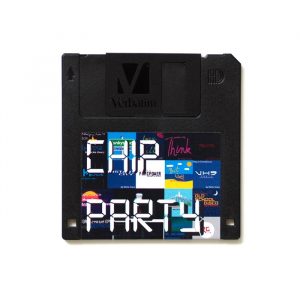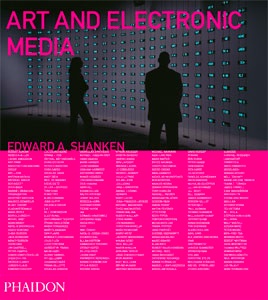 Art and Electronic Media. Edited by Edward A Shanken (Amazon USA and UK.)
Art and Electronic Media. Edited by Edward A Shanken (Amazon USA and UK.)
Publisher Phaidon says: This is the first book to explore mechanics, light, graphics, robotics, networks, virtual reality and the possibilities afforded by the web from an international perspective. It outlines the importance of figures previously neglected by art history, including engineers, technicians, and collaborators. Included are works by over 150 artists, both familiar – Jenny Holzer, Bruce Nauman, James Turrell, Mario Merz – as well as emerging and recent pioneers, such as Robert Lazzarini, Blast Theory, Granular Synthesis, Simon Penny, Marcel.li Antunez Roca, Mikami Seiko, and Jonah Bruckner-Cohen. The book is divided into seven thematic sections arranged chronologically. Art and Electronic Media is a lucid, accessible, and authoritative evaluation of continually developing media.
As part of the THEMES AND MOVEMENTS series, Art and Electronic Media is intended for uninitiated readers and scholars alike. They include a complete overview of each theme or movement, situating individual artists’ work in the context of modern art. Each book contains documents including artists’ statements; interviews; manifestos; project notes; reviews and articles by key critics; and parallel texts from other cultural, philosophical, and literary sources. Also featured are approximately 250 plates, including rarely-published installation shots and preliminary drawings. Finally, each book includes biographies of all the artists and authors involved, plus a comprehensive bibliography.
 Rebecca Horn, Concert for Anarchy, 1990
Rebecca Horn, Concert for Anarchy, 1990
Art and Electronic Media has received ecstatic endorsement by media art stars:
• “It is a superb work of scholarship, marked by clarity, subtlety, and comprehensive vision. Art and Electronic Media does us all a great service. More than any other publication that I know of, it will bring our field of practice into the mainstream of art.” – Roy Ascott
• “It’s the best book of its kind” – Casey Reas
• “This book will be quoted for decades to come” – Eduardo Kac
 Catherine Richards, Curiosity Cabinet at the End of the Millenium, 1995
Catherine Richards, Curiosity Cabinet at the End of the Millenium, 1995
I’m not quite as enthusiastic as they are but that doesn’t mean that i don’t find the book remarkable under a series of aspects.
First one is that, yes, the book might -maybe but not on its own- bring media art in the radar of contemporary art. Its decades of existence have not quite convinced the contemporary art world to fully embrace media art and a publication by Phaedon, a well-know producer of lavish objects that you will abandon on your coffee table for your guests to admire, could trigger the interest of major curators and art institutions. Besides, some artworks that have traveled the art shows around the globe are discussed in the book, establishing thus bridges between media art and the rest of the art world. One of them, Atsuko Tanaka’s Electric Dress, even appears on the back cover of the book.
 Lynn Hershman Leeson, CybeRoberta, 1970-1998
Lynn Hershman Leeson, CybeRoberta, 1970-1998
To me the biggest asset of the book is that it brings back to our attention a history of media art that has been forgotten or even has never been told in many media art schools (and i’d extend the criticism to interaction design schools.) It looks sometimes as if nothing has been achieved in the ’60s, ’70s, ’80s or even ’90s. I’ve seen so many involuntary ‘copies’ of Dan Graham’s 1974 Present Continuous Past(s) i’ve stopped counting. Art and Electronic Media should be compulsory reading for students interested in art and technology.
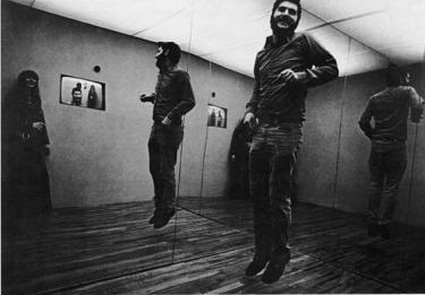 Dan Graham, Present Continuous Past (s), 1974
Dan Graham, Present Continuous Past (s), 1974
The last section of the book is superb. It compiles essays by critics and artists. After having spent hours going through the hundreds of art pieces which are illustrated and clearly explained in the “Works” section of the book, i was glad to be able to read or re-read texts such as Jasia Reichardt’s introduction to the exhibition Cybernetic Serendipity, Natalie Bookchin and Alexei Shulgin’s Introduction to net.art, Michael Rees’ Rapid Prototyping and Art, Lev Manovich’s On Totalitarian Interactivity, Stelarc’s The Body is Obsolete, subROSA’s Tactical Cyberfeminism: An Art and Technology of Social Relations, etc.
As i suggested above, i have a few critical remarks. One of them is the incredibly high proportion of artworks from the USA and Europe. There’s a couple of Japanese and Australian ones mentioned here and there but apart from Rafael Lozano-Hemmer, there’s almost no mention of media artists from Latin America. If you’re curious about the dynamism of media art in Latin America, i’d recommend the book that was published two years ago to accompany the exhibition Emergentes at LABoral in Gijón, Spain (cf Emergentes – 10 projects by Latin American artists, part 1 and part 2).
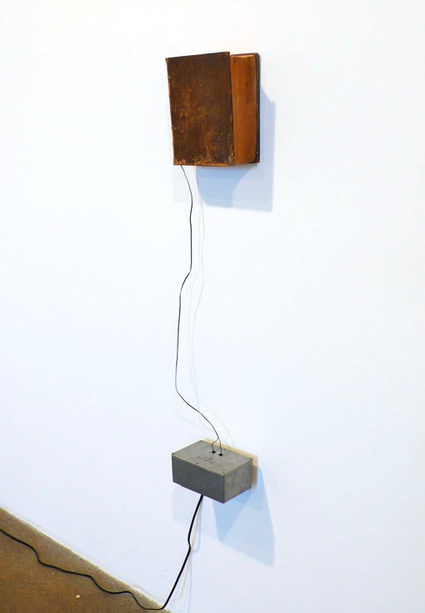 Jim Campbell, I Have Never Read The Bible, 1995 (movie)
Jim Campbell, I Have Never Read The Bible, 1995 (movie)
My main deception is that the book is a bit stiff. It shows only a slice of the world i discovered with enthusiasm almost 6 years ago. I’m not sure i’d have started we-make-money-not-art and dedicated it to media art (at some point, some of you will remember, the blog was covering only new media art) if i had known about it only through this book. It’s a great, useful and well-researched book but it doesn’t quite convey the fantastic dynamism of media art. For example, activism and hacktivism are given a fairly modest space. Critical Art Ensemble (plus Beatriz Da Costa and Shyh-shiun Shyu)’s Free Range Grain finds itself printed side by side to the Robotic Chair by Max Dean, Rafaelo D’Andrea and Matt Donovan. Maybe it’s because the artworks defile in the book in an almost chronological order. That’s a choice but maybe it doesn’t give rise to the most thought-provoking associations.
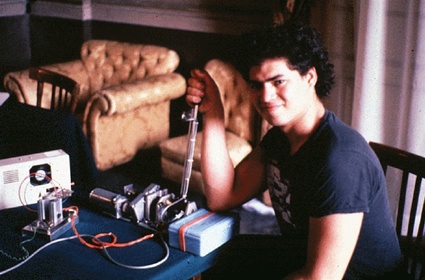 Doug Back and Norman White, Telephonic Arm Wrestling, 1986
Doug Back and Norman White, Telephonic Arm Wrestling, 1986
Photo on the homepage: Almacén de Corazonadas by Rafael Lozano Hemmer.

